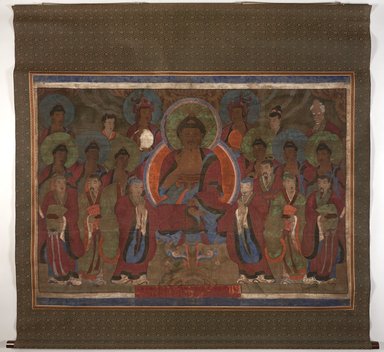
Artist:Korean
Medium: Hanging scroll: color on cloth
Geograhical Locations:
Dates:early 19th century
Dimensions: 81 × 75 in. (205.7 × 190.5 cm) image: 50 3/8 × 69 in. (128 × 175.3 cm) storage (wood handling/storage box): 4 1/2 × 4 1/2 × 82 in. (11.4 × 11.4 × 208.3 cm)
Collections:
Accession Number: 2017.29.41
Image: 2017.29.41_PS11.jpg,
Catalogue Description: Large, horizontal painting of Chil Sung, a group of figures who together represent the Seven Stars. The seven stars refer to the Big Dipper or Ursa Major, which is worshipped in Korean Shamanic tradition as the bringer of good or bad luck. Like certain other Shamanic deities, Chil Sung was adopted into Buddhist practice in Korea and shrines to the Seven Stars are often found in Buddhist complexes. Although treated as a single deity in Korean Shamanic tradition, the subject is most often found in art in Korean Buddhist contexts, where it is represented by a seated Buddha surrounded by other Buddhist deities and disciples. In Buddhist thought, the seven stars are sited in the urnas (jewel-like forehead spot on the faces of Buddhist deities) of seven Buddhist deities. A typical painting of the subject will show a Buddha flanked by the Bodhisattvas of the sun and moon (here shown holding their orbs) and four other heavenly bodies (here in the top row). He is also flanked by seven Buddhas (middle row plus one at the top right) and seven Star Princes (bottom row with one standing slightly above on the left side).